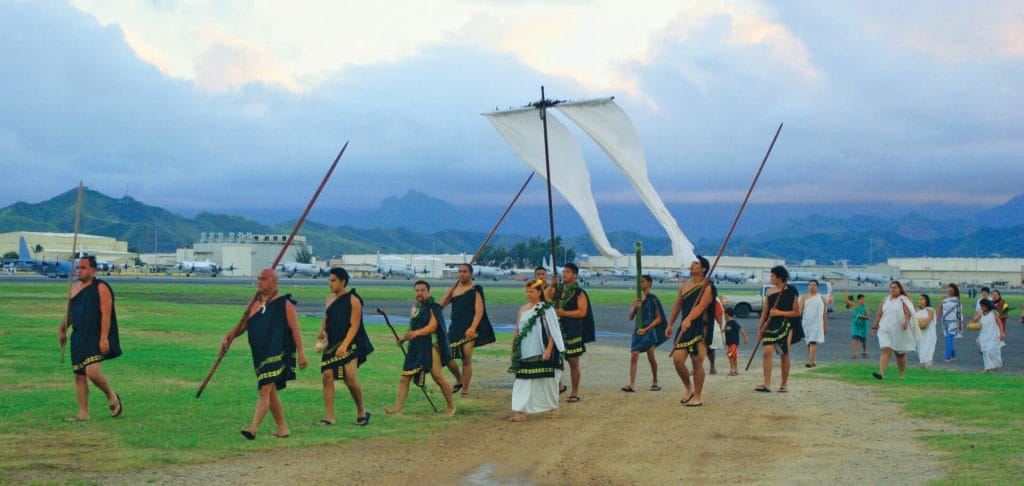As Makaliʻi continues to cross the night sky, Kānaka celebrate the Makahiki season, a tradition and festival celebrated since the days of Old Hawaiʻi. From November to February, Lono-i-ka-makahiki returns to Hawaiʻi from the sacred land of Kahiki with the first rains of hoʻoilo (the wet season), to usher in this four month harvest celebration, the Hawaiian New Year.
Lono governs the domains of peace, prosperity, fertility, and agriculture. To show reverence, all warfare and most forms of labor were kapu (forbidden) in his presence. This ushered in an important season of rest for the land and people, when the rains restored the earth, and the celebration restored the people.
When Lono visited Hawaiʻi, his divine presence would pass over the islands. Aliʻi (royalty) carrying his visage—as well as visages representing the other Makahiki gods—in the form of a wooden staff, would travel clockwise through the ahupuaʻa (land divisions) collecting hoʻokupu (offerings) in Lono’s name. Offerings included the best of the harvest, pigs, feathers, mats, and kapa bark cloth. These gifts thanked Lono for the year’s harvest and petitioned him for continued abundance in the coming year.

Upon Lono’s arrival for hānaipū, or “feeding Lono,” the people would continue to celebrate with feasts, hula, games, and sports. These challenges honed their bodies and tested their wit. The sports honored another Makahiki god, Akua Paʻani, god of sports. Many laws dictating the land were suspended or relaxed during this festival. As long as Lono remained in the ahupuaʻa, the makaʻāinana (commoners) would not work, but would celebrate with the Aliʻi instead.
Meanwhile, this was also an important time for data collection and strategic planning, as Hawaiʻi welcomed the new year. This was an important part of the next year’s success.
At the end of Makahiki, Lono would be sent off, back to Kahiki, in a waʻa (canoe) rich with offerings. As Kānaka watched this canoe drift to sea, they knew the season of Lono was over, and the god of war, Kū, would return.

The star cluster that rules the Makahiki season, Makaliʻi, is named after an ancient Kona chief whose greed led his people into a great famine. He hoarded food into a net and hung it from the sky. When the people starved, a brave ʻiole (rat) offered to ascend to the heavens and gnaw the net, so that the food could fall to the earth. The food fell like rain, as did the brave ʻiole, who fell back to the earth and landed at Kalaʻe, South Point. The stars that were tangled in the net were named after the chief who had snared them there.
Games Among Kānaka
Hawaiian chiefs, warriors, commoners, and children alike had upwards of 150+ games to choose from, which honed the mind, body, and/or spirit. We have preserved many of these into the modern day.
- Haka Moa: The “standing chicken fight” is one of the most well known Hawaiian games. Competitors use their left hand to hold one leg behind their back, and their right hand to grasp their opponent. The goal is to wrestle their opponent, or push them out of the small ring they’re in.
- He’e Hōlua: An ancient form of rock sledding. Atop a long, narrow sled called the papa hōlua, competitors would surf down from the mountain toward the ocean in this thrilling and dangerous sport. The largest remaining Hōlua slide (kahua hōlua) in Hawaiʻi is in Keauhou, called the Kāneaka Hōlua Slide.
- Heihei Kūkini: A racing game where competitors hurry to catch animals or enemies, or reach the finish in the shortest amount of time.
- Hukihuki: A familiar game to many, this is the Hawaiian sport of tug-of-war.
- Kōnane: An iteration of Hawaiian checkers or chess. The first player unable to capture an opponent’s piece on their turn loses. Pre-contact, Hawaiians used coral and lava pebbles for the playing pieces on an evenly pockmarked stone. One of the remaining stone boards can be found in Puʻuhonua o Hōnaunau National Historical Park.
- Ulu Maika: There are many iterations of this game of Hawaiian lawn bowling. All involve rolling a disk-like stone down a path, called the kahua maika. The most well-known version of this game is the distance competition, when competitors attempt to roll their stone, the ulu, farther than the rest.

Islandwide Makahiki Events
Celebrate the season of Lono with Vibrant Hawaiʻi’s Makahiki Resilience Hubs. These events feature a network of 40+ organizations and vendors that support and uplift the community. The Makahiki Resilience Hubs in particular highlight the ancestral practices of the season: celebration, reflection, and strategic planning.
January 21: Kāʻu
- Where: Nāʻālehu Hongwanji and Resilience Hub
- When: 10 AM – 2 PM
January 28: Laupāhoehoe
- Where: Laupāhoehoe Congregational Church
- When: 10 AM – 1 PM
As the contemporary Makahiki season closes, we remember why this tradition is important. These four months were a substantial opportunity for our kūpuna (ancestors) to reflect on our relationships: with our fellow man, the land, and the gods. And, in Hawaiian culture, when the gods and land are inseparable, this reflection is an opportunity to hone the relationship between the earth and its children. This time is a reminder to be generous like the land, and rest is the key to a renewed spirit.
Want to get outside during Makahiki season? Check out our 2023 Guide to Viewing Kīlauea Volcano and Where to See Native Plants on the Big Island.

1 thought on “Celebrating Makahiki: A Time of Peace and Rest”
Comments are closed.